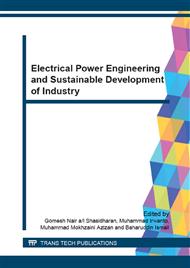[1]
Nisha G. K, Z.V. Lakaparampil, and S. Ushakumari, FFT Analysis for Field Oriented Control of SPWM and SVPWM Inverter fed Induction Machine With and Without Sensor, International Journal of Advanced Electrical and Electronics Engineering, vol. 2, Issue 4, p.30.
DOI: 10.1109/icgt.2012.6477943
Google Scholar
[2]
Joachim Holtz and Juntao Quan, Sensorless Vector Control of Induction Motors at Very Low Speed using a Nonlinear Inverter Model and Parameter Identification, IEEE Transactions on Industry Applications, vol. 38, No. 4, July/Aug 2002, pp.1087-1095.
DOI: 10.1109/tia.2002.800779
Google Scholar
[3]
Arpit Shah, Divyesh Mangroliya, and Nirav Vaghela, Simulation and Analysis of an Advanced 150° Conduction Mode for Three Phase Voltage Source Inverter, Association of Computer Electronics and Electrical Engineers, 2013, DOI: 03. AETS. 2013. 3. 101.
Google Scholar
[4]
Ebrahim Babaei, Mehdi Mahaei, Improving Output Voltage of the Three Phase Six-Switch Inverters, TELKOMNIA, vol. 9, No. 3, December 2011, pp.497-502.
DOI: 10.12928/telkomnika.v9i3.741
Google Scholar
[5]
Venkata Anil Babu Polisetty, B.R. Narendra2, Enhanced Performance of Multilevel Inverter Fed Induction Motor Drive, International Journal of Advanced Research in Electrical, Electronics and Instrumentation Engineering, vol. 2, Issue 11, November (2013).
Google Scholar
[6]
Arun Kumar. R, PG Scholar, PED, VIT University, Chennai Campus Indirect Field Oriented Control of Induction Motor Using Fuzzy Logic.
Google Scholar
[7]
A. S. N. Mokhtar, M. B. I. Raez, Mohd. Marufuzzaman, M. A. M. Ali, Hardware Implementation of a High Speed Inverse Park Transformation using CORDIC and PLL for FOC Brushless Servo Drive, ELEKTRONIKA IR ELEKTROTECHNIKA, vol. 19, No. 3, (2013).
DOI: 10.5755/j01.eee.19.3.1267
Google Scholar
[8]
C. C. de Azevedo, C.B. Jacobina, L.A.S. Ribeiro, A.M.N. Lima and A.C. Oliveira, Indirect Field Orientation for Induction Motors without Speed Sensor, Applied Power Electronics Conference and Exposition, vol. 2, March 2002, pp.809-814.
DOI: 10.1109/apec.2002.989337
Google Scholar
[9]
K. Vinoth Kumar, Prawin Angel Michael, Joseph P. John and Dr. S. Suresh Kumar, Simulation and Comparsion of SPWM and SVPWM Control for Three Phase Inverter, ARPN Journal of Engineering and Applied Sciences, vol. 5, No. 7, July (2010).
Google Scholar
[10]
Ananya Dutta, Some Aspects on 3-Phase Bridge Inverter (180 Degree Mode), International Journal of Engineering Inventions, vol. 3, Issue 4, November 2013, pp.18-21.
Google Scholar


